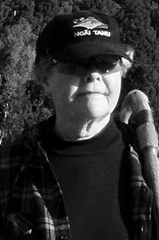He KōreroreroHe Pūoro
Jul 12, 2012

Nā Keri Hulme
They don’t look like much, to an undiscerning eye.
Some rocks and bits of wood, a few bones… cordage, and vegetable matter that is not wood.
I display them on top of the shelves for Māori CDs, and the complete “Ngā Mōteatea”.
A long time ago, when travelling to the second Māori Artists & Writers hui, I met a man who was composing nursery rhymes for his children. He wanted the kids to have small songs that would cuddle them to sleep, songs in Māori, intrinsic to our islands. His name was Hirini Melbourne.
He sang one on the bus that haunted me. It was about pīpīwharauroa, the shining cuckoo.
I don’t know why, but that bird has fascinated me ever since I first heard it, on the West Coast in 1970. I learned that it was one of the navigators’ birds, and it journeyed from the Bismarck and Solomon archipelagos to breed here. The chicks hatched in grey warbler nests and their first act was to heave out the grey warbler eggs (and chicks, if any). Sometimes the chicks overwintered here (and you’d hear them calling in August) and sometimes they’d grown enough to head northwards before our winter set in, and you wouldn’t hear them until late September.
A few years later, I learned that Hirini, and a Pākehā bloke I didn’t know, were resurrecting the old musical instruments. They were almost too late – there was one taua in Wellington who knew how to play the kōauau, and that seemed to be all there was…
The Pākehā bloke was Richard Nunns. He is a profoundly skilled musician who has an especial gift with wind instruments. I’ve heard him play a crayfish leg-shell. I’ve heard him play a fossil snail-home. I’ve heard him play a human tibia –
For over a decade, Hirini and Richard researched deeply, travelling to many marae, and journeying overseas (in the British Museum, they found a pounemu toaka, labelled “greenstone pendant”, that turned out to be a weka call. A copy of that has been played in Ōkarito: auē, weka were eaten out there in the early part of last century by starving Pākehā, and have never returned – so nothing answered).
The copy was made in soapstone by the third resurrector – the carver of genius, Brian Flintoff. As the 3 travelled around, playing and teaching, a lot of sequestered knowledge came back into the daylight. For instance, they learned that a simple kid’s toy/noisemaker porotiti – (I was taught to make them with large flat buttons!) was used to assist people with congested lungs, among other functions.
Every musical instrument had a ritual aspect as well as practical uses. The two could be combined. When Richard swung his pounemu pūrerehua by the sea under the Bluff cliffs, I automatically looked to the waves. And saw 2 Hector’s dolphins. From my long-ago childhood I had learned that bullroarers were used to call dolphins, and lure them to shore…
So. There they sit above the music, my squatty but wonderful little singing treasures:
*2 sets of poi — one made in traditional materials, the other corn-husks and wool… I can’t wield the traditional ones, but I love the sharp rap they make, in contrast to the others (which I keep for visitors to play with)
*a tap-stick, made by Brian in rātā, the shape of a mantis but with a humanoid face*a plain but beautiful pūrerehua, made by a young Pākehā, who just wanted to give a gift — rātā one side, yes, the other (to signify different ancestral lines) very skillfully knit together*a kōauau in venison bone carved by Brian (has about the density of human bone said Richard, when he gave it to me)
*a wonderful porotiti made from a slice of pilot-whale vertebrae — it resounds mightily (and will carve your fingers off if you get it spinning too swiftly)
* a simple rounded knocked-smooth rock. Indeed, it is a hammer stone, brought to me by Richard from a Nelson argillite quarry, together with an adze blank. Knocked together, they make a quite loud ringing sound…working in that argillite quarry 3–4 centuries ago must’ve been… interesting.
When I strike the adze-blank with the mantid-stick, it produces a sharp noise or a chirrup, depending where you hit it.
*And, 2 ordinary sea-ground greywacke flat pebbles, about the size of my hand. Stroked across each other, they make a soft susurration, like slow waves washing over beach gravel…
In family places, there are other treasures – most of an old kōauau, albatross bone, with incised cross-hatching; an interesting fractured slab of pounemu, unworked, that will sing out an astonishing distance, if correctly suspended ( a lot pounemu hei will ring too), and an old trade Jew’s harp —
I rarely publicly recommend books. There is one I am happy to, in this context.
“Taonga Puoro — Singing Treasures” by Brian Flintoff. In it, you will see Hirini & Richard & enjoy Brian’s work (and treasures made by other craftspeople). You can learn to play the rejuvenated ancient instruments. You can make versions of them. And you can hear what they sound like –